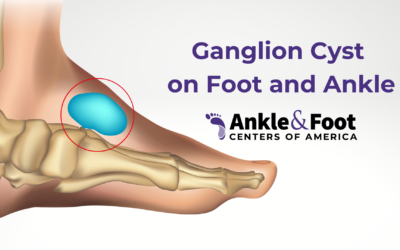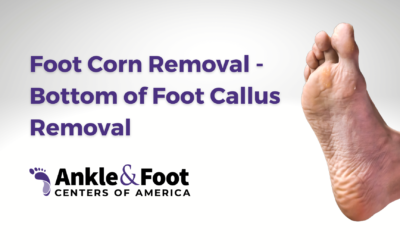Sports-related foot and ankle injuries
Sports- related foot and ankle injuries can occur to athletes of all ages, sizes, and skill levels. These injuries can range in severity and are often times caused by wearing poor footwear, quick movements, uneven surfaces, overuse, or anything else that may cause ankle to be in an unnatural position. Some of the most common ankle injuries are sprains, strains, and fractures. Ankle injuries are determined by the kind of tissue that is damaged. Bones are held together by ligaments, which are strong tissue bands that keep bones in place. Tendons are tissue that attach our muscles to our bones, and muscles do the work that allows us to move.
How does a podiatrist diagnose an ankle injury?
You may wonder, how a podiatrist would diagnose an ankle injury. Often times they will ask how the incident took place. The examination of the ankle would include looked for swelling, deformities, and bruising. The doctor may need to move the ankle to determine the level of pain and swelling. An X-ray may be necessary to determine if there are broken bones or an MRI for a more detailed image of the injury. Treatments for ankle injuries depend on the severity of the injury. Minor ankles injuries could be healed anywhere from 1-3 weeks. Minor injury treatments will typically include rest, ice, compression, and elevation, also known as the RICE method. While more severe incidents such as fractures may require physical therapy or surgery. In this case, the ankle could take up to 6 to 9 weeks for the bone to heal completely.
Sprains
Ankle Sprains are the most common type of sports-related ankle injuries. Sprains occur when the ligaments that are attached to the bones are stretched passed their normal range of motion. Landing on uneven surfaces, twisting your ankle, or landing awkwardly could lead to a sprain. If you are experiencing symptoms including tenderness, swelling, bruising or weakness in your ankle, you may have an ankle sprain. A common acronym to treat sprained ankles is RICE: rest, ice, compression, and elevation. Some more severe sprains may be recommended physical therapy to help rebuild the affected ligaments.
Tendinitis
Tendinitis is an injury caused by the stress and overuse of the tendons which leads to inflammation. This occurs when microscopic tendon tears accumulate by being over stretched. Repetitive motions or overly strenuous motions such as jumping or running are common causes of tendinitis. Tendinitis can cause pain when moving, swelling, weakness, or a grating feeling in tendon. The most common treatment for tendinitis is ice, rest, over the counter pain relievers, or physical therapy.
Strains
Although, ankle strains are less common than sprains, excessive use or repeating movements could still lead to a strained ankle. Unlike a sprain, a strain affects the muscles or tendons in the ankle. The muscles or tendons being stretched or pulled too far can lead to a strain. Strained ankles may cause stiffness, tenderness, or swelling. Rest, ice, compression and elevation is also recommended to treat strains, along with physical therapy for more strains of more severity.
Fractures
An ankle fracture are the least common sports- related ankle injury, but can still occur through sudden impact. Falling from a tall height or colliding with another player could lead to ankle fractures. A fracture take places when at least one bone has a break in them. Symptoms are fractures typically include: throbbing pain, swelling, bruising, inability to put weight on ankle, and possible deformity. Fractures can be treated with non-surgical or surgical treatments depending on the severity of the break.
Preventing Sports-related injuries
 Avoiding injury is crucial to every athlete’s performance and health. Almost all sports-related injuries are preventable with the proper precautions. There are few different ways athletes can prevent ankle and foot injuries that are related to sports. Wearing the proper footwear, ones which provide support and fit properly, is one way to help prevent ankle and foot injuries. Warming up before sport- related activities and doing cool-down stretches after sport-related activities, is often skipped over, but is very crucial to preventing injuries. Strength training to gain muscles in your ankles and avoiding overuse especially while doing repetitive movements, are some other ways to help prevent injuries to the foot and ankle. By taking proper precautions you can continue your sport and perform at your highest capacity. If you need guidance in preventing or treating foot or ankle injuries, physical therapist and athletic trainers are good resources.
Avoiding injury is crucial to every athlete’s performance and health. Almost all sports-related injuries are preventable with the proper precautions. There are few different ways athletes can prevent ankle and foot injuries that are related to sports. Wearing the proper footwear, ones which provide support and fit properly, is one way to help prevent ankle and foot injuries. Warming up before sport- related activities and doing cool-down stretches after sport-related activities, is often skipped over, but is very crucial to preventing injuries. Strength training to gain muscles in your ankles and avoiding overuse especially while doing repetitive movements, are some other ways to help prevent injuries to the foot and ankle. By taking proper precautions you can continue your sport and perform at your highest capacity. If you need guidance in preventing or treating foot or ankle injuries, physical therapist and athletic trainers are good resources.
Other sports-related injuries
In addition to these injuries, which are most common, there is a wide variety of other injuries related back to sports that could take place. Turf toe, plantar fasciitis, blisters, neuroma, and heel spurs are just a few of the other conditions that can affect athletes and their ability to play their sport comfortably and healthily.
Treating Sports-Related Injuries
A podiatry specialist can provide the most education on injury prevention and how to manage an injury that has already occurred. A podiatrist will be your best resource for the guidance on the rehabilitation of your strength, range of motion, and mobility. It is important to seek help from a specialist as soon as possible after a sports-related injury occurs in order to minimize any further damage. The best way to a quick recovery is seeking treatment from a professional.
In conclusion, these types of sports related injuries can happen to anyone who partakes in an active lifestyle. There are many different type of injuries that can take place but the most common are sprains, strains and fractures. It is extremely important that athletes understand of the causes of these injuries, so they can take the proper steps to prevent them. Athletes who are experiencing any symptoms of ankle and foot injuries should seek treatment from their local podiatrist as soon as possible. With the correct care, all sports-related injuries can be healed and managed.
About the Author: Dr. Jamil Hossain
 Originally from Bangladesh, he went to the University of Florida to study biology. Dr. Hossain graduated from Temple University School of Podiatric Medicine in 2012. After his doctorate, he attended Hahnemann University Hospital, a program of Drexel University located in Philadelphia. While at Hahnemann he served as chief resident, for his last year. He is now a licensed Podiatrist in Tennessee. Dr. Hossain has been serving Nashville area in podiatry for the past 5 years. He has dedicated his professional career to helping individuals with wound care, minimally invasive heel surgery, and ankle arthroscopy. He is very experienced in all facets of podiatry, including diabetic limb salvaging and foot reconstructions. He is passionate about providing quality care to all patients.
Originally from Bangladesh, he went to the University of Florida to study biology. Dr. Hossain graduated from Temple University School of Podiatric Medicine in 2012. After his doctorate, he attended Hahnemann University Hospital, a program of Drexel University located in Philadelphia. While at Hahnemann he served as chief resident, for his last year. He is now a licensed Podiatrist in Tennessee. Dr. Hossain has been serving Nashville area in podiatry for the past 5 years. He has dedicated his professional career to helping individuals with wound care, minimally invasive heel surgery, and ankle arthroscopy. He is very experienced in all facets of podiatry, including diabetic limb salvaging and foot reconstructions. He is passionate about providing quality care to all patients.




